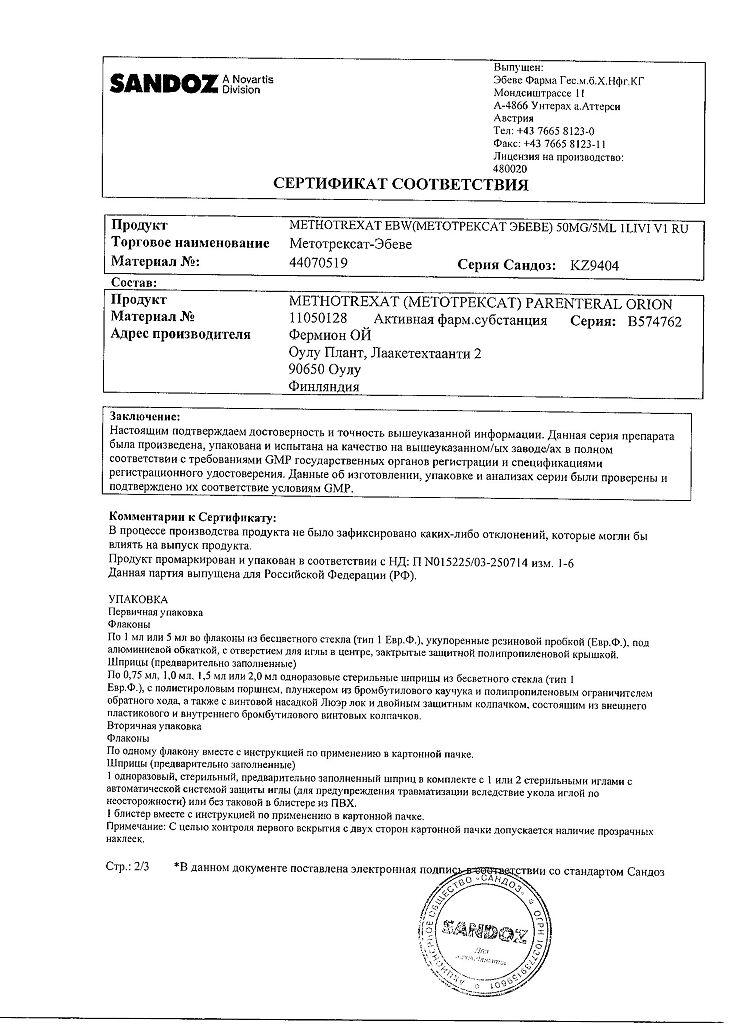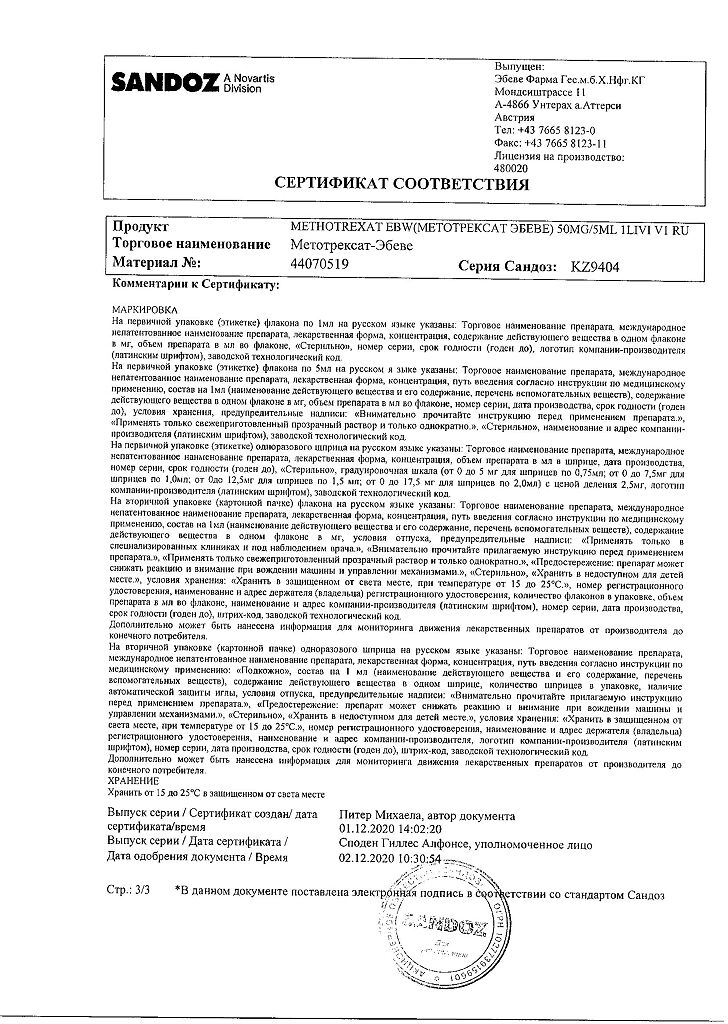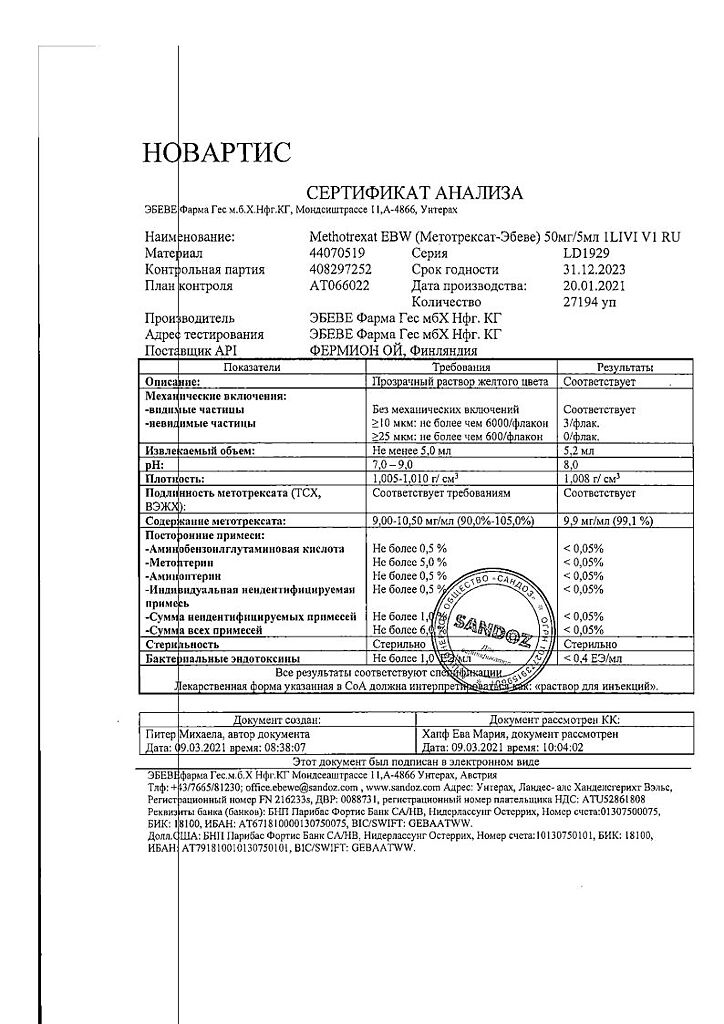No products in the cart.
Description
Antitumor drug from the group of antimetabolites – analogues of folic acid. Along with antitumor, it has immunosuppressive effect.
Inhibits dihydrofolate reductase, which participates in the reduction of dihydrofolic acid to tetrahydrofolic acid – the carrier of carbon fragments necessary for the synthesis of purine nucleotides and their derivatives.
Inhibits synthesis, DNA repair and cellular mitosis (in the synthesis phase). Tissues with high cell proliferation are particularly sensitive to the action of methotrexate: tumor tissue, bone marrow, mucosal epithelial cells, embryonic cells.
When the cell proliferation of malignant tissue is greater than in most normal tissue, methotrexate can lead to disruption of malignant growth without irreversible damage to normal tissue.
The mechanism of action in rheumatoid arthritis is unknown; it may be due to the immunosuppressive properties of methotrexate.
In patients with rheumatoid arthritis, use of methotrexate reduces symptoms of inflammation (pain, swelling, stiffness), but there are limited studies on long-term use of methotrexate (regarding the ability to maintain remission in rheumatoid arthritis).
The growth rate of keratinocytes in psoriatic plaques is increased in psoriasis compared to normal skin cell proliferation. This difference in cell proliferation is the basis for the use of methotrexate to treat psoriasis.
Indications
Indications
– trophoblastic tumors;
— acute leukemia (especially lymphoblastic and myeloblastic variants);
– neuroleukemia;
– non-Hodgkin’s lymphomas, including lymphosarcoma;
– breast cancer, squamous cell cancer of the head and neck, lung cancer, skin cancer, cervical cancer, vulvar cancer, esophageal cancer, kidney cancer, bladder cancer, testicular cancer, ovarian cancer, penile cancer, retinoblastoma, medulloblastoma;
— osteogenic sarcoma and soft tissue sarcomas;
— mycosis fungoides (advanced stages);
– severe forms of psoriasis, psoriatic arthritis, rheumatoid arthritis, dermatomyositis, SLE, ankylosing spondylitis (if standard therapy is ineffective).
Pharmacological effect
Pharmacological effect
An antitumor drug from the group of antimetabolites – folic acid analogues. Along with antitumor, it has an immunosuppressive effect.
Inhibits dihydrofolate reductase, which is involved in the reduction of dihydrofolic acid to tetrahydrofolic acid – a transporter of carbon fragments necessary for the synthesis of purine nucleotides and their derivatives.
Inhibits DNA synthesis, repair and cell mitosis (during the synthesis phase). Tissues with high cell proliferation are especially sensitive to the action of methotrexate: tumor tissue, bone marrow, epithelial cells of the mucous membranes, embryonic cells.
When cellular proliferation in malignant tissues is greater than in most normal tissues, methotrexate may impair the growth of malignant tumors without permanent damage to normal tissue.
The mechanism of action in rheumatoid arthritis is unknown, but it may be due to the immunosuppressive properties of methotrexate.
In patients with rheumatoid arthritis, the use of methotrexate reduces symptoms of inflammation (pain, swelling, stiffness), but there is limited research on long-term use of methotrexate (regarding the ability to maintain remission in rheumatoid arthritis).
In psoriasis, the growth rate of keratinocytes in psoriatic plaques increases compared to the normal proliferation of skin cells. This difference in cell proliferation is the basis for the use of methotrexate to treat psoriasis.
Special instructions
Special instructions
Methotrexate can only be prescribed by an oncologist with experience in antineoplastic chemotherapy. Taking into account the risk of severe toxic reactions, including death, the doctor is obliged to inform the patient in detail about the possible risk and the necessary safety measures.
If a significant amount of fluid in the pleural cavities or ascites is detected in a patient, the fluid should be evacuated by drainage before starting methotrexate therapy or the use of methotrexate should be discontinued.
The appearance of symptoms of toxic damage to the digestive system, the earliest of which is stomatitis, requires temporary cessation of methotrexate therapy due to the high risk of developing hemorrhagic enteritis and intestinal perforation with a fatal outcome if therapy is continued.
During treatment with methotrexate, patients should be closely monitored in order to promptly identify signs of possible toxicity and adverse effects. Given the risk of severe or even fatal toxic reactions, patients should be thoroughly informed about possible complications and recommended precautions.
Before starting treatment with methotrexate or when resuming therapy after a break, it is necessary to conduct a clinical blood test with counting the leukocyte formula and platelet count, assess the activity of liver enzymes, the concentration of bilirubin, serum albumin, as well as a chest x-ray and renal function tests. If there are clinical indications, studies are prescribed to exclude tuberculosis and hepatitis.
During treatment with methotrexate (monthly in the first 6 months and at least every 3 months thereafter, with increasing doses it is advisable to increase the frequency of examinations) the following studies are carried out:
1. Examination of the mouth and throat to identify changes in the mucous membranes.
2. Blood test to determine the leukocyte formula and platelet count. Even when used in normal therapeutic doses, methotrexate can suddenly cause depression of the hematopoietic system. If there is a significant decrease in the number of leukocytes or platelets, treatment with methotrexate is stopped immediately and symptomatic supportive therapy is prescribed. Patients should be instructed to immediately report any signs and symptoms indicating an infection to their physician. During concomitant therapy with hematotoxic drugs (for example, leflunomide), it is necessary to carefully monitor the number of leukocytes and platelets in the blood.
3. Functional liver tests. Particular attention should be paid to identifying signs of liver damage. Treatment with methotrexate should not be started or should be suspended if there is any abnormality in the results of liver function tests or liver biopsy. Typically, the indicators return to normal within two weeks, after which treatment can be resumed according to the doctor’s decision. When using methotrexate for rheumatological indications, there is no reason to perform a liver biopsy to monitor the hepatotoxic effect of the drug. When treating patients with psoriasis, it is necessary to evaluate the advisability of performing a liver biopsy before or during treatment with methotrexate, based on current scientific recommendations. This assessment should differentiate between patients without risk factors and patients at risk (eg, those with a history of alcohol abuse, those with persistently elevated liver enzymes, a history of liver disease, a family history of hereditary liver disease, patients with diabetes mellitus, obese patients, and previous use of hepatotoxic drugs or exposure to hepatotoxic chemicals). In case of persistent increase in liver enzyme activity, it is necessary to reduce the dose or discontinue treatment with methotrexate.
Since methotrexate has a toxic effect on the liver, other hepatotoxic drugs should not be prescribed during treatment with the drug unless clearly necessary. You should also avoid or greatly reduce your alcohol consumption. Liver enzyme activity should be especially closely monitored in patients receiving concomitant therapy with other hepatotoxic and hematotoxic drugs (in particular, leflunomide).
4. Renal function tests and urine examination. Since methotrexate is excreted primarily by the kidneys, patients with impaired renal function may experience increased concentrations of methotrexate in the blood, which may result in severe adverse reactions. It is necessary to carefully monitor the condition of patients who may have impaired renal function (for example, elderly patients). This is especially important in the case of concomitant therapy with drugs that reduce the excretion of methotrexate, have an adverse effect on the kidneys (in particular, NSAIDs) or on the hematopoietic system. Dehydration may also potentiate the toxic effects of methotrexate.
5. Study of the respiratory system. It is necessary to closely monitor symptoms of possible development of pulmonary function disorders and, if necessary, order a pulmonary function test. Pulmonary diseases require rapid diagnosis and discontinuation of methotrexate. The appearance of corresponding symptoms (especially a dry, nonproductive cough) or the development of nonspecific pneumonitis during treatment with methotrexate may indicate a potential danger of lung damage. In such cases, methotrexate is discontinued and the patient is carefully examined. Although the clinical presentation may vary, the typical patient with methotrexate-induced pulmonary disease exhibits fever, cough with dyspnea, hypoxemia, and pulmonary infiltrates on x-ray. In the differential diagnosis, infectious diseases should be excluded. Lung damage can occur during treatment with methotrexate at any dose.
6. Because methotrexate affects the immune system, it may alter the response to vaccinations and affect the results of immunological tests. Particular caution is required when treating patients with inactive, chronic infections (such as herpes zoster, tuberculosis, hepatitis B or C) due to their possible activation. During treatment with methotrexate, vaccination with live vaccines should not be performed.
It is recommended that methotrexate treatment be interrupted one week before surgery and restarted one or two weeks after surgery.
When body temperature rises (more than 38°C), the elimination of methotrexate slows down significantly.
Methotrexate may increase the risk of developing neoplasms (mainly lymphomas). Malignant lymphomas can also develop in patients receiving low-dose methotrexate. In such cases, the drug is discontinued. If spontaneous regression of lymphoma is not observed, therapy with cytotoxic drugs is prescribed.
Before starting treatment with Methotrexate-Ebeve, pregnancy must be excluded. Methotrexate has an embryotoxic effect, promotes abortion and the formation of fetal development abnormalities. Methotrexate therapy is accompanied by inhibition of spermatogenesis and oogenesis, which can lead to decreased fertility. After discontinuation of methotrexate therapy, these effects spontaneously regress. During methotrexate therapy and for 6 months after its completion, patients are recommended to use contraception. Patients of reproductive age, as well as their partners, should be informed about the possible effects of methotrexate on reproduction and development.
The life-threatening consequences of intrathecal administration of methotrexate are well known, so in each individual case it is necessary to assess the balance of risk and expected benefit from therapy. When the first signs of serious side effects appear, the drug is discontinued.
During therapy with high doses, precipitation of methotrexate or its metabolites in the renal tubules may occur. In such cases, to prevent this complication, it is recommended to carry out infusion therapy and alkalization of urine until a pH of 6.5-7.0 is achieved through oral or intravenous administration of sodium bicarbonate (5 tablets of 625 mg every 3 hours) or acetazolamide (500 mg orally 4 times a day).
Methotrexate-Ebewe does not contain preservatives, therefore only a single withdrawal of the drug from the container is allowed, and unused solutions must be disposed of.
Solutions for infusion with a concentration of methotrexate of 0.1 mg/ml or 3 mg/ml, prepared by diluting Methotrexate-Ebewe with 0.9% sodium chloride solution, 5% glucose solution, 10% glucose solution, and lactated Ringer’s solution, are physically and chemically stable for at least 24 hours if stored in a place protected from light, at 5±3°C or room temperature (20-25°C). From a microbiological point of view, the solution for infusion should be administered immediately after preparation.
Methotrexate-Ebeve should not be mixed with other medications in the same infusion bag or vial.
When manipulating methotrexate solutions, it is necessary to follow the rules for handling cytotoxic substances. Pregnant healthcare workers should not work with the drug.
Measures should be taken to prevent methotrexate solutions from coming into contact with the skin and mucous membranes. If the drug does get on the skin or mucous membranes, the affected area is immediately washed with plenty of water.
Residues of the drug and all instruments and materials used to prepare Methotrexate-Ebewe infusion solutions should be disposed of in accordance with standard hospital cytotoxic waste disposal procedures, taking into account applicable hazardous waste disposal regulations.
Impact on the ability to drive vehicles and operate machinery
Due to the potential for side effects such as drowsiness, headache and confusion, caution should be exercised when engaging in potentially hazardous activities that require increased concentration and psychomotor speed.
Active ingredient
Active ingredient
Methotrexate
Composition
Composition
1 ml – methotrexate 10 mg.
Contraindications
Contraindications
— severe renal failure (creatinine clearance < 20 ml/min);
– severe liver failure;
– alcohol abuse;
– a history of hematopoietic system disorders (in particular, bone marrow hypoplasia, leukopenia, thrombocytopenia or clinically significant anemia);
– severe acute and chronic infectious diseases such as tuberculosis and HIV infection;
– concomitant vaccination with live vaccines;
– oral ulcers, gastrointestinal ulcers in the active phase;
– simultaneous use of methotrexate at a dose of ≥15 mg/week. with acetylsalicylic acid;
– pregnancy;
– lactation period;
– hypersensitivity to methotrexate and/or any other component of the drug;
The drug is used with caution in patients with impaired liver and kidney function, diabetes mellitus, obesity and previous exposure to hepatotoxic drugs, dehydration, ascites, suppression of bone marrow hematopoiesis, pleural or peritoneal effusion, parasitic and infectious diseases of a viral, fungal or bacterial nature – the risk of developing a severe generalized disease (currently or recently suffered, including recent contact with a patient – herpes simplex, herpes zoster (viremic phase), chicken pox, measles, amoebiasis, strongyloidiasis (established or suspected)); gout (including a history) or urate nephrourolithiasis (including a history), infection and inflammation of the oral mucosa, vomiting, diarrhea, gastric and duodenal ulcers, ulcerative colitis, obstructive gastrointestinal diseases, previous chemotherapy or radiation therapy, asthenia, aciduria (urine pH less than 7), as well as in children and elderly patients.
Side Effects
Side Effects
According to WHO, undesirable effects are classified according to their frequency of development as follows: very often (≥1/10), often (from ≥1/100 to <1/10), infrequently (from ≥1/1000 to <1/100), rarely (from ≥1/10,000 to <1/1000), very rarely (<1/10,000); frequency unknown - based on available data, it was not possible to determine the frequency of occurrence.
From the hematopoietic system: often – suppression of bone marrow function (leukopenia, thrombocytopenia, anemia); uncommon – pancytopenia; very rarely – severe progressive suppression of bone marrow function, agranulocytosis; frequency unknown – megaloblastic anemia.
From the central nervous system: often – drowsiness, headache, fatigue; infrequently – depression, confusion, mood changes; rarely – when using methotrexate in low doses – transient slight impairment of cognitive functions, unusual sensations in the cranial area; very rarely – pain, myasthenia gravis or paresthesia in the extremities, perversion of taste (metallic taste in the mouth), epileptic seizures, meningism, paralysis, insomnia.
From the senses: often – visual impairment; uncommon – eye irritation; rarely – conjunctivitis.
From the respiratory system: often – chronic interstitial pneumonitis (symptoms indicating potentially serious damage to the lungs with interstitial pneumonitis: dry, unproductive cough, shortening of breathing, increased body temperature); uncommon – alveolitis, pleural effusion; rarely – pulmonary fibrosis, Pneumocystis pneumonia, bronchial asthma; very rarely – pleural pain and thickening of the pleura (when treated with methotrexate in high doses), acute pulmonary edema.
From the digestive system: very often – stomatitis, nausea, inflammation of the mucous membranes, loss of appetite, dyspepsia, anorexia, significant increase in the activity of liver transaminases; often – diarrhea, ulceration of the oral mucosa; uncommon – enteritis, vomiting, liver cirrhosis, liver fibrosis, liver steatosis; rarely – ulceration of the gastrointestinal mucosa; very rarely – malabsorption syndrome, toxic megacolon.
From the urinary system: infrequently – inflammation and ulceration of the bladder, impaired renal function, urinary disorders; rarely – renal failure, oliguria, anuria, electrolyte imbalance.
From the skin: often – exanthema, erythema, itching; uncommon – photosensitivity, alopecia, herpes zoster, vasculitis, skin rashes herpetiformis, urticaria; rarely – increased pigmentation; very rarely – Stevens-Johnson syndrome, epidermal necrolysis (Lyell’s syndrome). When exposed to ultraviolet radiation, increased psoriatic skin lesions, increased pigmentation of nails, acute paronychia, furunculosis and hidradenitis.
From the musculoskeletal system: infrequently – arthralgia, myalgia, osteoporosis.
From the cardiovascular system: often – vasculitis, bleeding of various locations; infrequently – effusion into the pericardial cavity; rarely – cardiac tamponade, nosebleeds.
From the immune system: very often – decreased resistance to infections, pharyngitis; uncommon – hypogammaglobulinemia; rarely – sepsis; very rarely – anaphylactic reactions, increased number of rheumatoid nodules.
From the reproductive system: infrequently – ulceration and inflammation of the vagina; very rarely – loss of libido, impotence, oligospermia, menstrual disorders, vaginal discharge.
Other: often – chills, malaise, fever, necrosis; rarely – deterioration of wound healing. With intramuscular injection – a burning sensation or tissue damage (formation of a sterile abscess, destruction of adipose tissue) at the injection site; very rarely – benign, malignant and nonspecific neoplasms (including cysts and polyps), lymphomas, which in some cases regress after discontinuation of methotrexate; frequency unknown – diabetes, other metabolic disorders, sudden death.
Adverse reactions with intrathecal administration of methotrexate
Acute: chemical arachnoiditis, manifested by headache, back or shoulder pain, stiffness in the muscles of the back of the neck and fever.
Subacute: paresis (usually transient), paraplegia, impaired cerebellar function.
Chronic: leukoencephalopathy, manifested by irritability, confusion, ataxia, muscle plasticity, sometimes convulsions, dementia, drowsiness, coma, in rare cases with death. When combining radiation therapy to the cranial area and intrathecal administration of methotrexate, the incidence of leukoencephalopathy increases.
Interaction
Interaction
The likelihood of hepatotoxicity from methotrexate increases with regular alcohol consumption and concomitant use of other hepatotoxic drugs.
With combination therapy with methotrexate and leflunomide, the incidence of pancytopenia and hepatotoxic effects increases.
Oral antibiotics (tetracyclines, chloramphenicol and non-absorbable broad-spectrum antibiotics) may reduce gastrointestinal absorption of methotrexate and interfere with enterohepatic circulation due to inhibition of intestinal microflora or suppression of bacterial metabolism.
Penicillins, ciprofloxacin, cephalothin, glycopeptides can reduce the renal clearance of methotrexate, as a result of which its concentration in the blood serum may increase and the toxic effect on the hematopoietic system and gastrointestinal tract may increase.
Probenecid, weak organic acids (for example, loop diuretics) and pyrazoles (phenylbutazone) may slow down the elimination of methotrexate, which may result in increased serum concentrations and increased hematological toxicity.
The risk of toxic effects of methotrexate increases when used in combination with NSAIDs or salicylates.
When concomitant therapy with drugs that may have an adverse effect on the bone marrow (for example, sulfonamides, trimethoprim/sulfamethoxazole, chloramphenicol, pyrimethamine), the possibility of developing more severe hematological disorders should be taken into account.
With concomitant therapy with drugs that cause folate deficiency (for example, trimethoprim/sulfamethoxazole), the toxic effect of methotrexate may be enhanced.
The simultaneous use of indirect anticoagulants and lipid-lowering drugs (cholestyramine) increases the toxicity of methotrexate.
With the combined use of antirheumatic drugs (for example, gold salts, penicillamines, hydroxychloroquines, azathioprines, cyclosporines) and methotrexate, the toxic effect of the latter is not enhanced. In the case of simultaneous use of sulfasalazine and methotrexate, the effect of the latter may be potentiated due to inhibition of folic acid synthesis.
When methotrexate is co-administered with proton pump inhibitors (e.g. omeprazole or pantoprazole), the renal elimination of methotrexate may be delayed and pantoprazole may inhibit the renal elimination of the 7-hydroxymethotrexate metabolite, which in one case was accompanied by the development of myalgia and tremor.
During treatment with methotrexate, excessive consumption of drinks containing caffeine and theophylline (coffee, sweet drinks containing caffeine, black tea) should be avoided. Methotrexate reduces the clearance of theophylline.
It is necessary to take into account the pharmacokinetic interaction between methotrexate and flucloxacillin and anticonvulsants (the concentration of methotrexate in the blood decreases), 5-fluorouracil (the half-life of 5-fluorouracil increases).
When used together with other cytostatics, the clearance of methotrexate may be reduced.
Oral vitamin or iron supplements containing folic acid may alter the response to methotrexate therapy.
When mixing solutions of methotrexate with chlorpromazine hydrochloride, droperidol, idarubicin, metoclopramide hydrochloride, heparin, prednisolone sodium phosphate and promethazine hydrochloride, precipitation or turbidity of the solution may occur.
Due to competitive binding to serum albumin, with simultaneous use of methotrexate with phenylbutazones and phenytoin, the toxicity of methotrexate may be increased.
Several patients with psoriasis or mycosis fungoides treated with methotrexate in combination with PUVA therapy (methoxsalen and ultraviolet radiation) have been diagnosed with skin cancer.
Caution should be exercised when administering packed red blood cells and methotrexate simultaneously.
Combination with radiotherapy may increase the risk of soft tissue necrosis.
Methotrexate may reduce the immunological response to vaccination. When administered simultaneously with a live vaccine, severe antigenic reactions may develop.
L-asparaginase is an antagonist of methotrexate.
Anesthesia using dinitrogen oxide can lead to the development of unpredictable severe myelosuppression and stomatitis.
Amiodarone may promote skin ulceration.
Parenteral use of acyclovir against the background of intrathecal administration of methotrexate increases the risk of developing neurological disorders.
Overdose
Overdose
Symptoms: symptoms associated with inhibition of the hematopoietic system are mainly observed.
Treatment: the specific antidote for methotrexate is calcium folinate. It neutralizes adverse toxic effects.
In case of accidental overdose, no later than an hour after the administration of methotrexate, administer calcium folinate (IV or IM) in a dose equal to or higher than the dose of methotrexate. The administration of calcium folinate is continued until the concentration of methotrexate in the blood serum decreases below the level of 10-7 mmol/l.
In case of significant overdose, it may be necessary to hydrate the body and alkalinize the urine (pH more than 7) to prevent sedimentation of methotrexate and/or its metabolites in the renal tubules. Hemodialysis and peritoneal dialysis do not improve the elimination of methotrexate. Intensive intermittent hemodialysis using high-flux dialyzers allows effective clearance of methotrexate.
In case of overdose with intrathecal administration, repeated lumbar punctures should be performed immediately to ensure rapid drainage of cerebrospinal fluid, possibly neurosurgical intervention with ventriculolumbar perfusion. All these procedures should be performed against the background of intensive supportive care and systemic administration of large doses of calcium folinate.
Storage conditions
Storage conditions
The drug should be stored out of the reach of children, protected from light at a temperature of 15-25°C.
Shelf life
Shelf life
3 years.
Manufacturer
Manufacturer
Fareva Unterach GmbH, Austria
Additional information
| Shelf life | 3 years. |
|---|---|
| Conditions of storage | The drug should be kept out of reach of children, protected from light at a temperature of 15-25 ° C. |
| Manufacturer | Fareva Untereh GmbH, Austria |
| Medication form | solution for injection |
| Brand | Fareva Untereh GmbH |
Related products
Buy Methotrexate-Ebeve, 10 mg/ml 5 ml with delivery to USA, UK, Europe and over 120 other countries.




















